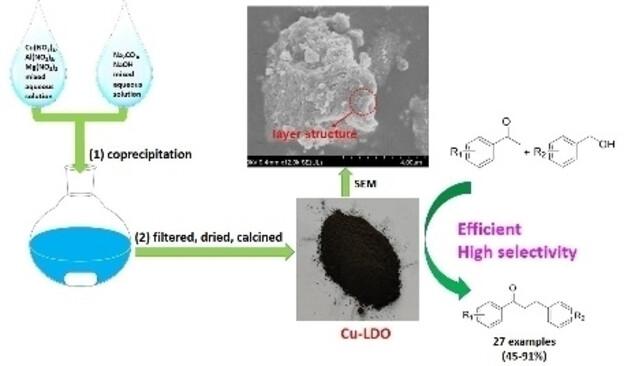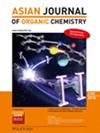Efficient Cu‐Based Mixed Oxides Catalyst for α‐Alkylation of Ketones with Alcohols
IF 2.8
4区 化学
Q1 CHEMISTRY, ORGANIC
引用次数: 0
Abstract
A series of Cu‐based mixed oxides were prepared by calcinations of corresponding CuMgAl‐layered double hydroxides precursors at different temperatures with nominal Cu/Mg/Al ratios of 1 : 1 : 2(Cu‐LDH‐1), 1 : 2 : 1(Cu‐LDH‐2),1 : 1 : 1(Cu‐LDH‐3), and 2 : 1 : 1(Cu‐LDH‐4). The synthesized catalysts were characterized using X‐ray diffraction, high‐resolution transmission electron microscopy, scanning electron microscopy, X‐ray photoelectron spectroscopy, Fourier transform infrared spectroscopy, inductively coupled plasma atomic emission spectroscopy (ICP‐AES), and N2 physisorption analysis techniques. All as‐obtained catalysts showed adequate catalytic performance for the α‐alkylation of ketones with alcohols through a hydrogen autotransfer mechanism. The catalyst CuMgAl‐I‐650 (obtained by calcining Cu‐LDH‐1 at 650 °C) displayed the highest activity and selectivity. Using this catalyst system, a wide range of branched ketones were synthesized in good to excellent isolated yields. Moreover, the catalyst CuMgAl‐I‐650 could be recycled and reutilized for four cycles without any significant loss of activity and selectivity. This study provides a very simple and inexpensive catalysis based on transition metals, which are in abundance on earth.

高效铜基混合氧化物催化剂用于酮与醇的α-烷基化反应
通过在不同温度下煅烧相应的铜镁铝层双氢氧化物前驱体,制备了一系列铜基混合氧化物,铜/镁/铝的标称比例分别为 1:1:2(Cu-LDH-1)、1:2:1(Cu-LDH-2)、1:1:1(Cu-LDH-3)和 2:1:1(Cu-LDH-4)。利用 X 射线衍射、高分辨率透射电子显微镜、扫描电子显微镜、X 射线光电子能谱、傅立叶变换红外光谱、电感耦合等离子体原子发射光谱 (ICP-AES) 和 N2 物理吸附分析技术对合成的催化剂进行了表征。所有获得的催化剂在通过氢自转移机理进行酮与醇的α-烷基化反应中都表现出了良好的催化性能。催化剂 CuMgAl-Ⅰ-650(由 Cu-LDH-1 在 650 ° C 煅烧得到)显示出最高的活性和选择性。使用该催化剂体系合成了多种支链酮,分离产率从良好到极佳。此外,催化剂 CuMgAl-Ⅰ-650 可循环使用四次,其活性和选择性均无明显下降。这项研究以地球上丰富的过渡金属为基础,提供了一种非常简单和廉价的催化方法。
本文章由计算机程序翻译,如有差异,请以英文原文为准。
求助全文
约1分钟内获得全文
求助全文
来源期刊

Asian Journal of Organic Chemistry
CHEMISTRY, ORGANIC-
CiteScore
4.70
自引率
3.70%
发文量
372
期刊介绍:
Organic chemistry is the fundamental science that stands at the heart of chemistry, biology, and materials science. Research in these areas is vigorous and truly international, with three major regions making almost equal contributions: America, Europe and Asia. Asia now has its own top international organic chemistry journal—the Asian Journal of Organic Chemistry (AsianJOC)
The AsianJOC is designed to be a top-ranked international research journal and publishes primary research as well as critical secondary information from authors across the world. The journal covers organic chemistry in its entirety. Authors and readers come from academia, the chemical industry, and government laboratories.
 求助内容:
求助内容: 应助结果提醒方式:
应助结果提醒方式:


